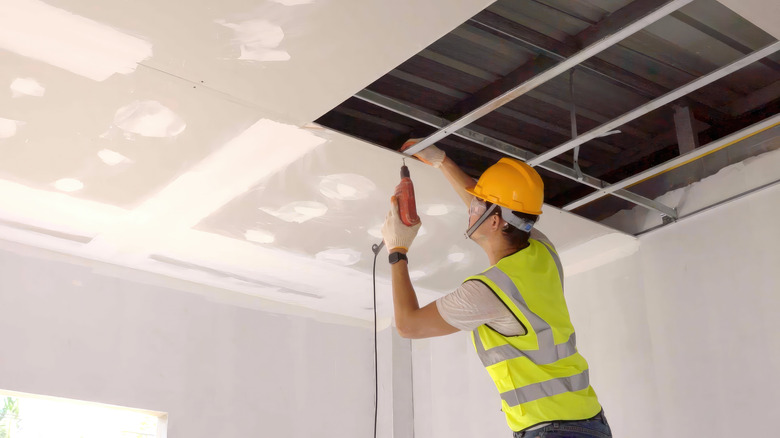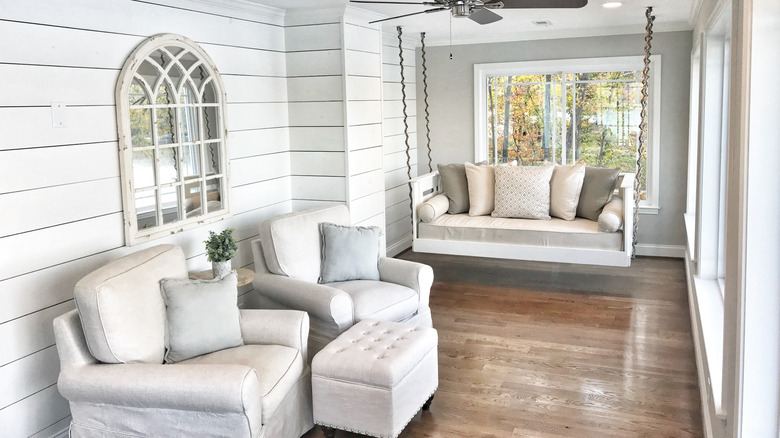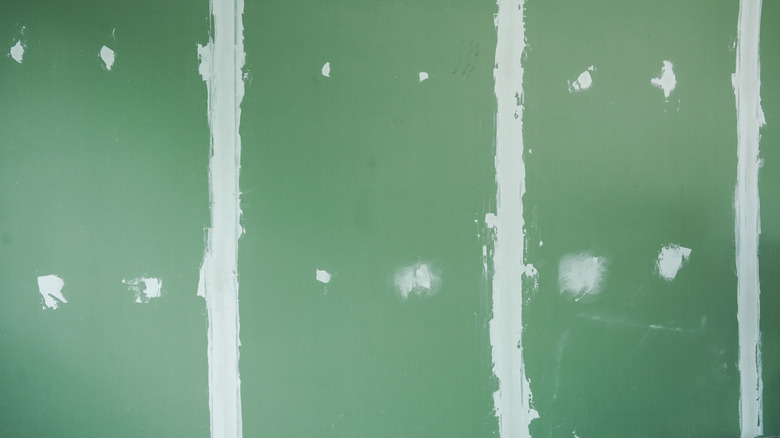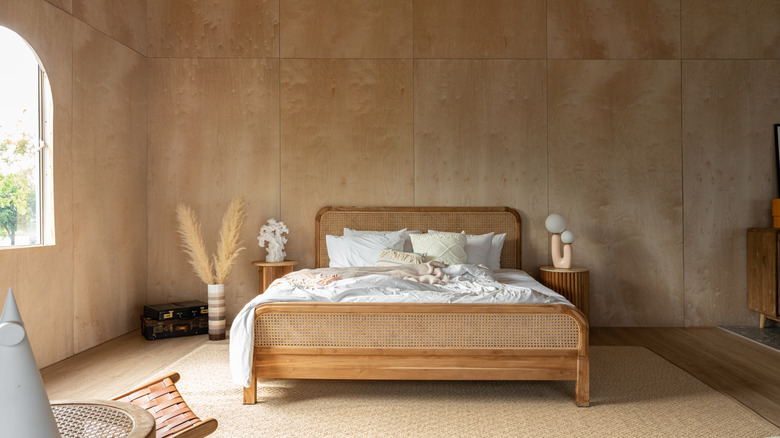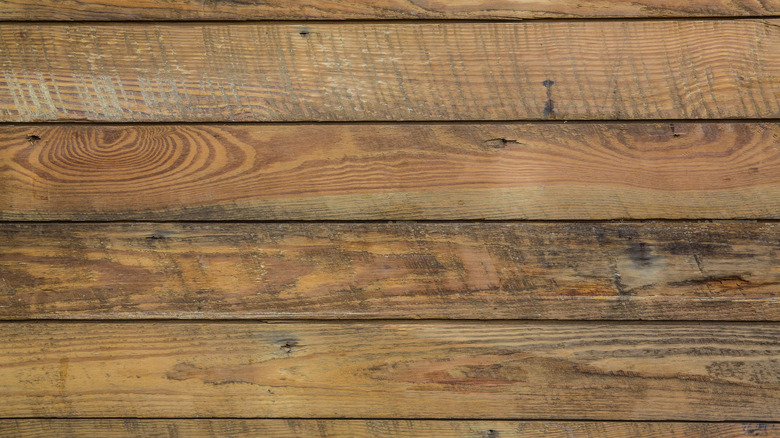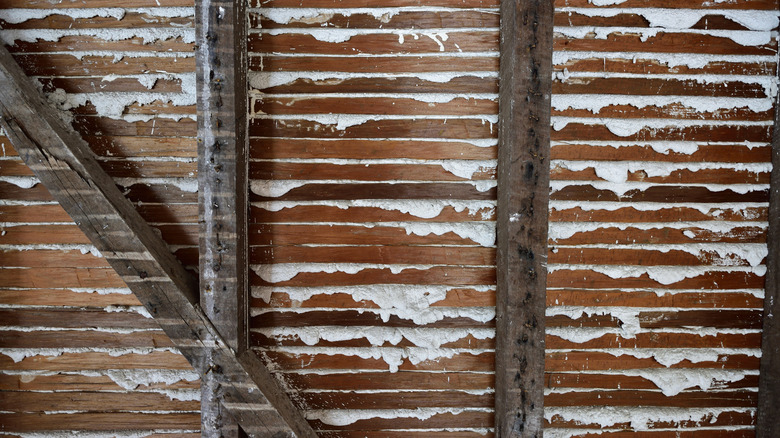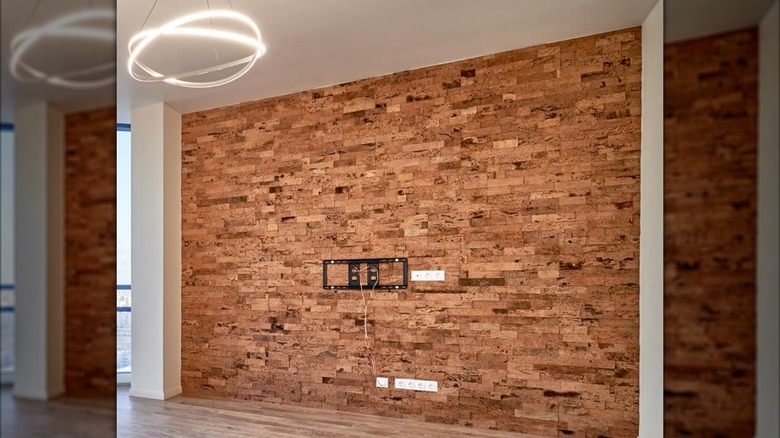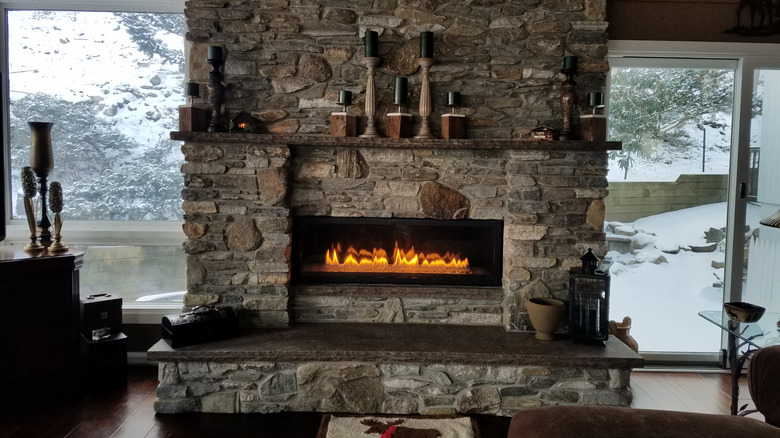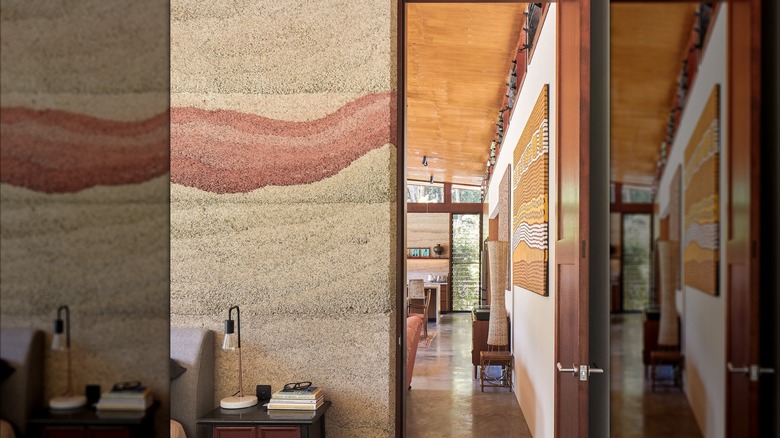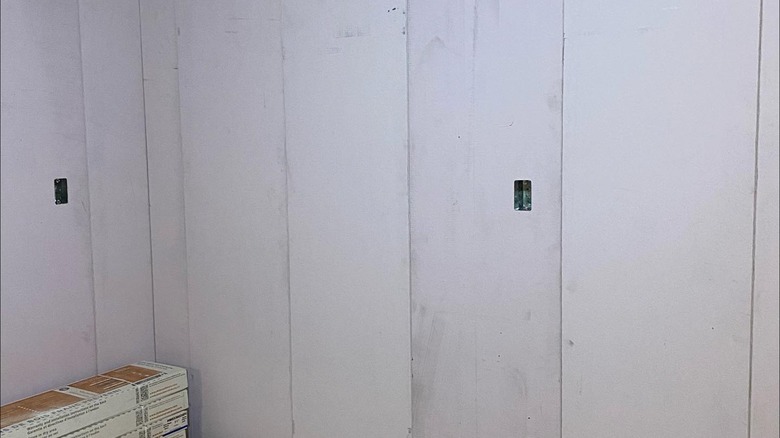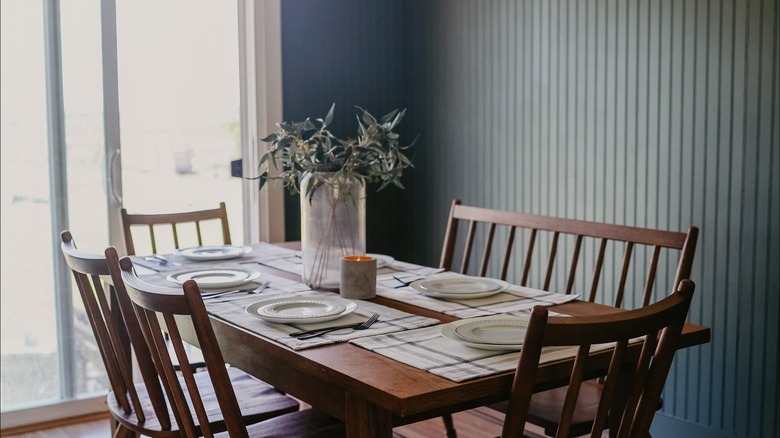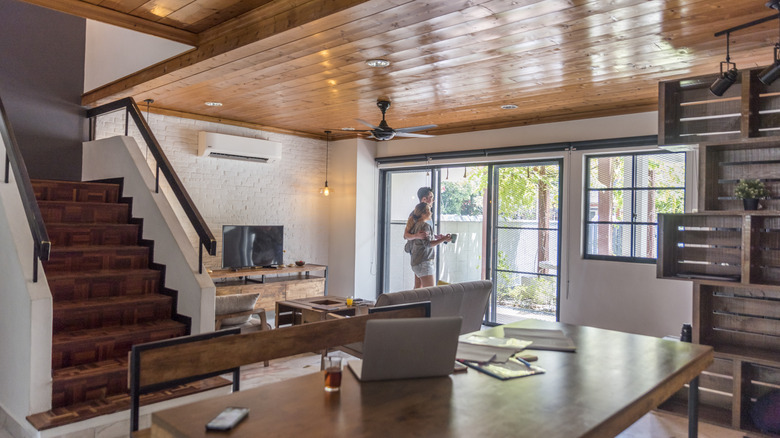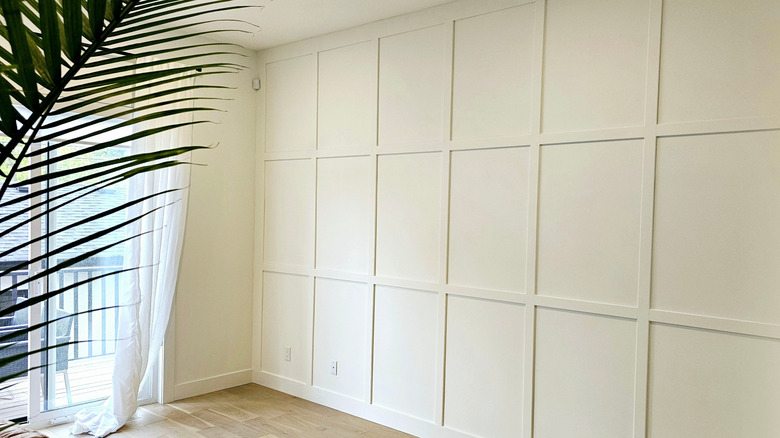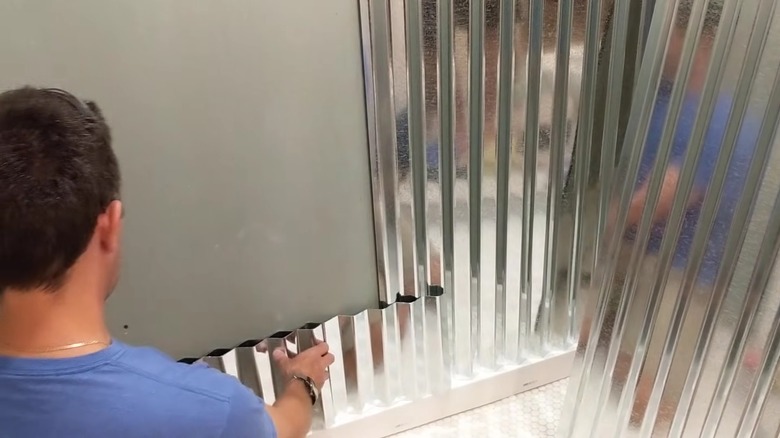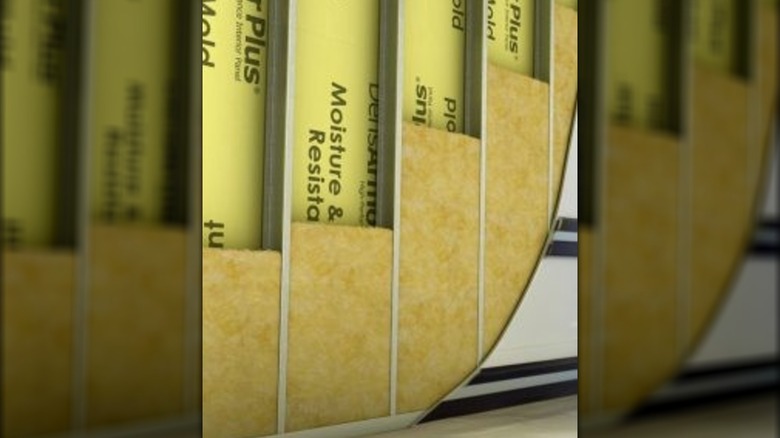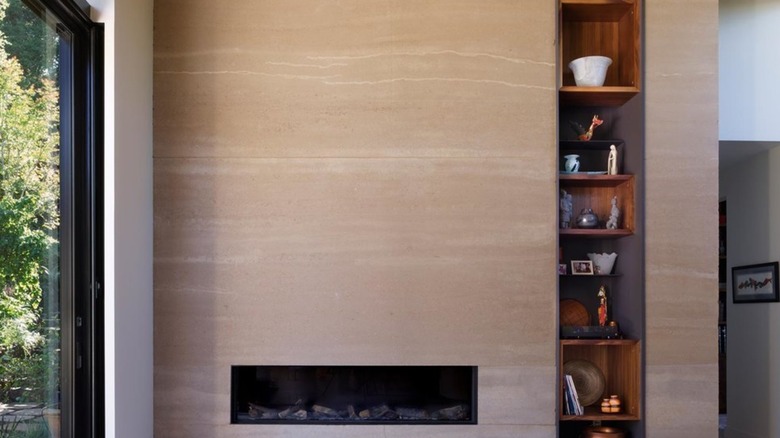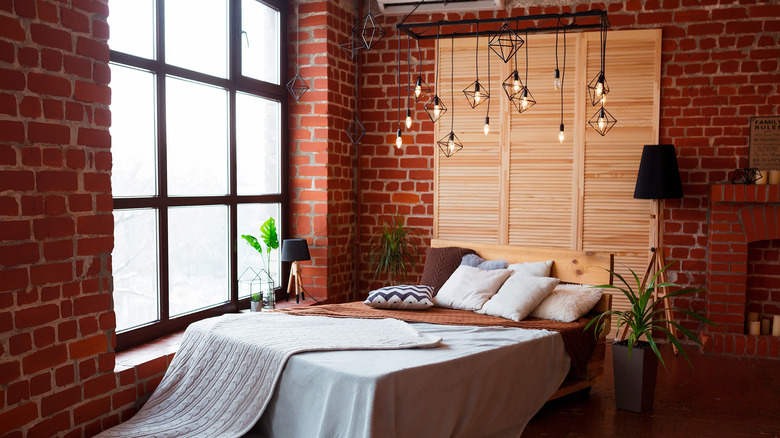16 Drywall Alternatives That Will Look Just As Good In Your Home
Given its ubiquity across U.S. dwellings, you'd think nothing can match up to drywall when finishing a wall. Made by compressing gypsum plaster between layers of paper pulp, drywall sheets are often budget friendly. Since they're fire-resistant, meeting the building code is a breeze. Plus, you can DIY them once you know everything you need to hang drywall like a pro. Yet, when the drywall phase rolls around during construction, most homeowners feel jittery thinking about the dust caking their interiors (and lungs). After all, there is no escaping the sanding and mudding processes. Besides the installation unease, drywall presents its fair share of problems, such as susceptibility to termite infestations and mold, and an inability to repel moisture. Drywall is also quick to take damage and dent, making it a poor fit in garages and work sheds. Worse yet, it's monotonous!
Clearly, there is a need for drywall alternatives for all the times you must finish walls in wet areas or break the aesthetics mold. Fortunately, the market doesn't disappoint with its heady offerings of shiplap, plywood, PVC panels, corrugated metal, cork walls, and more, as listed below. However, before investing in any of these alternatives, make sure to account for their material and labor costs, ease of installation, and performance. Also, don't shy away from mixing and matching different materials to create a unique, personalized statement. Ready to explore the most popular options? Let's go through the load of drywall alternatives!
Shiplap
When visual appeal matters, shiplap is a standout choice. These overlapping wooden boards — a near-staple in old-time ships — add a rustic charm, reminding homeowners of coastal waters. These textured walls can be hung right onto studs and fit in well with the farmhouse interior style. To create a spacious look, opt for broader boards. While shiplap is slightly pricier than drywall, it lends itself better to DIY installation, assuming you're good with a saw and a hammer. However, the paneling is prone to collecting dust in its seams, requiring regular upkeep and maintenance. Worse, it reacts to humidity, warping easily.
Cement board
Although cement board lacks the design range that drywall offers, it's a better fit in and around moisture-laden areas, such as bathrooms, laundry rooms, kitchens, and basements. Its moisture-repellent fibers help prevent mold from entering your home or at least reduce the scale of the mildew problems over extended periods. Since cement board is highly durable, it can be safely finished with stones and tiles as desired. However, these boards are heavy and difficult to cut, so they're best installed by professionals. Also, cement board doesn't lend itself well to curved designs.
Plywood
If you're tired of avoiding false positives with your stud finder, move on to plywood panels. This way, you can fasten your knick-knacks onto the plywood surface without worrying about them falling off the wall. After all, plywood is highly durable thanks to its stacked layering, making it precious in busy areas like garages and work sheds. Plywood's thermal insulation outmatches drywall's, which is why these sheets are often used on ceilings in chillier regions. As plywood comes in diverse designs, from wood to shiplap, you're almost guaranteed to find a suitable fit at an affordable price. However, plywood isn't resistant to fire or noise and may take water damage.
Barnwood panels
Don't spurn barnwood for being passé, for it remains the go-to durable choice when a place requires some bucolic countryside charm. Besides, since these panels are made of reclaimed wood, you can even snag them for free with the right connections, making them an economical and eco-friendly choice. While barnwood panels can't match the range of drywall, they can still be styled differently through painting, staining, and some stripping. Alternatively, look for engineered barnwood panels for a better assortment of designs. Skip this option if pests and excessive moisture tend to find their way inside your home.
Lath and plaster
Call it on the nose if you will, considering drywall was pitched as plaster's replacement. But if you're ready to sit out the period while the plaster dries in metal (or wood) frames and pay for the skilled labor, lath and plaster may be a great drywall alternative. It holds up well against moisture, making it useful in areas prone to flooding. It adds a rustic feel, reminiscent of historic buildings. Compared to drywall, this solution offers better fire resistance and insulative properties. Consider using lath and plaster in your music or office room to benefit from its superior soundproofing properties.
Cork board walls
Missed the memo about the cork board wall ideas that'll upgrade your home office? Well, here's your friendly reminder because cork walls are anything but boring (unlike drywall). They aren't very durable, so you couldn't hang shelves on them the way you would on plywood — any heavy items should be fastened to the studs beyond. However, if the point is to create an accent wall, give these eco-friendly boards a go. Cork board walls are great at suppressing sound waves, which makes them handy in noisy playrooms or music rooms. These walls also offer great thermal insulation.
Stone veneer
Mimicking the look of natural stone, stone veneer is another option to finish your brick, masonry, or concrete walls. If you've got framed walls, you'll have to screw a metal lath to the studs first to support the stone veneer. So, bear this requirement in mind before settling on it to decorate your fireplaces, the kitchen, or interior cabin walls. Although the veneer is durable and holds its own against dents and scratches, it doesn't resist moisture well unless you stain or seal it.
Hempcrete boards
Those who prize sustainability may consider hempcrete as a drywall substitute. As the name implies, hempcrete is essentially made of multiple water-soaked hemp bark tissues that have been banded together with lime. This composition creates a durable, stone-like material with amazing insulation and soundproofing properties. Moreover, hempcrete remains unbothered by termites, fires, and mold or mildew issues, leading to better indoor air quality and making it worth the price. However, note that hempcrete walls require specialized wood framing, so they're easier to install if you're designing and building a new home.
DRICORE SMARTWALL
In damp environments like basements, a product like DRICORE SMARTWALL may be a worthy alternative to drywall because its mold resistant. Since DRICORE SMARTWALL comprises a modular panel system, installing it is relatively simple and mess free (although some mudding and sanding is still necessary). There's no need to add insulation behind these panels, since they already come with a thermal resistance rating of R-15. Despite their insulative properties, these panels are slimmer than drywall, maximizing the available, functional real estate in your home.
Beadboard
Usually, beadboard goes on top of drywall to dress the area elegantly in its grooved Victorian charm. However, if the wood is at least a ¼ inch thick, these boards can be fastened directly onto the studs without the need for gypsum. Depending on your budget, you can opt for natural or engineered wood beadboard. However, take note that beadboard panels aren't fire-resistant. Plus, while it's tempting to employ them in living and dining areas for added warmth and texture, they might swell and get damaged in spaces with excessive moisture.
PVC panels
PVC panels present a more durable, moisture-resistant, and low-maintenance alternative to drywall. They may also be placed in bathrooms, mud rooms, or laundry rooms since they resist moisture and humidity well. While they're fussy about being painted, you can change things up with different finishes, ranging from matte to marble. PVC panels are easy to install using either fasteners or an adhesive. They stand up well to dents and insect infestations and are long-lived. However, once damaged, they're difficult to repair. Since they're not fire resistant, don't install PVC panels in kitchens or near the fireplace.
Board and batten panels
Popular since the Victorian era and ubiquitous as a barn siding material in the U.S., board and batten panels offer yet another option to clothe your interior walls, especially around busy areas like entryways, hallways, family rooms, or dining areas (with chain rails). They're available in steel, fiber board, as well as natural and engineered wood. Their installation can be easily DIY-ed, as the boards are lightweight and don't need to be taped. However, limit them to large walls or ones that aren't half-hidden by cabinets, so you can enjoy the design.
Corrugated metal wall panels
Use corrugated metal wall panels to add an artistic touch to your home and turn it into a conversation starter. Aesthetics aside, metal walls promise high durability and fire resistance, as they can take plenty of damage and are not vulnerable to rot and mold. They're also available in different finishes, like brass and rust, to accommodate diverse interior styles, from industrial chic to farmhouse. You can even salvage old metal sheets to DIY your accent wall. However, corrugated metal panels can be expensive and will eat up your square footage due to their profile.
Fiberglass mat gypsum boards
If your only complaint about drywall is its tendency to get moldy after exposure to moisture, fiberglass mat gypsum boards might be your new best friend. They retain drywall's staid look, fire resistance, and convenience but showcase improved opposition to mold growth (for a price to match). So, they're cool to have in wet spaces like kitchens, mud rooms, bathrooms, and basements. Painting these boards could be difficult due to the uneven finish, but they can be decked with tiles. You can easily screw them onto metal or wood frames, ensuring easy installation.
Rammed earth wall panels
Usually available as prefabricated panels — though you may get them built on site — rammed earth walls are exactly what they sound like. That is, they're layers of soil that get compressed compactly until the desired thickness and durability levels are reached. These panels are floor mounted but also get fastened to the home's framing. Since rammed earth walls often hand-tamped, each panel looks unique. While their insulative performance isn't the best, these panels' soil-based composition gives them a high thermal mass and allows them to retain and emit heat for a long time.
Exposed brick or concrete blocks
Love the industrial chic aesthetic but don't have a historic or a row house whose brick walls can be loosened of their plaster? Try thrifting some reclaimed bricks and having masons over to build a brick feature wall to replace (or conceal) a drywall section. While it may get expensive, it's a charming way to make your place cozy (especially basements). However, if you aren't game for the upkeep — natural stone and plaster do get flaky over time — you could opt for concrete panel veneer and profit off its insulative properties, as well as its fire, rust, and termite resistance.
